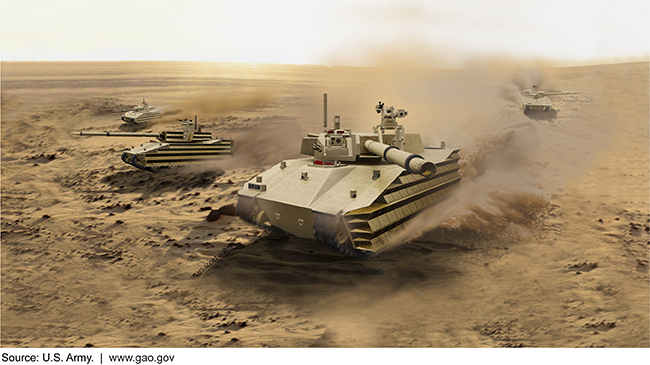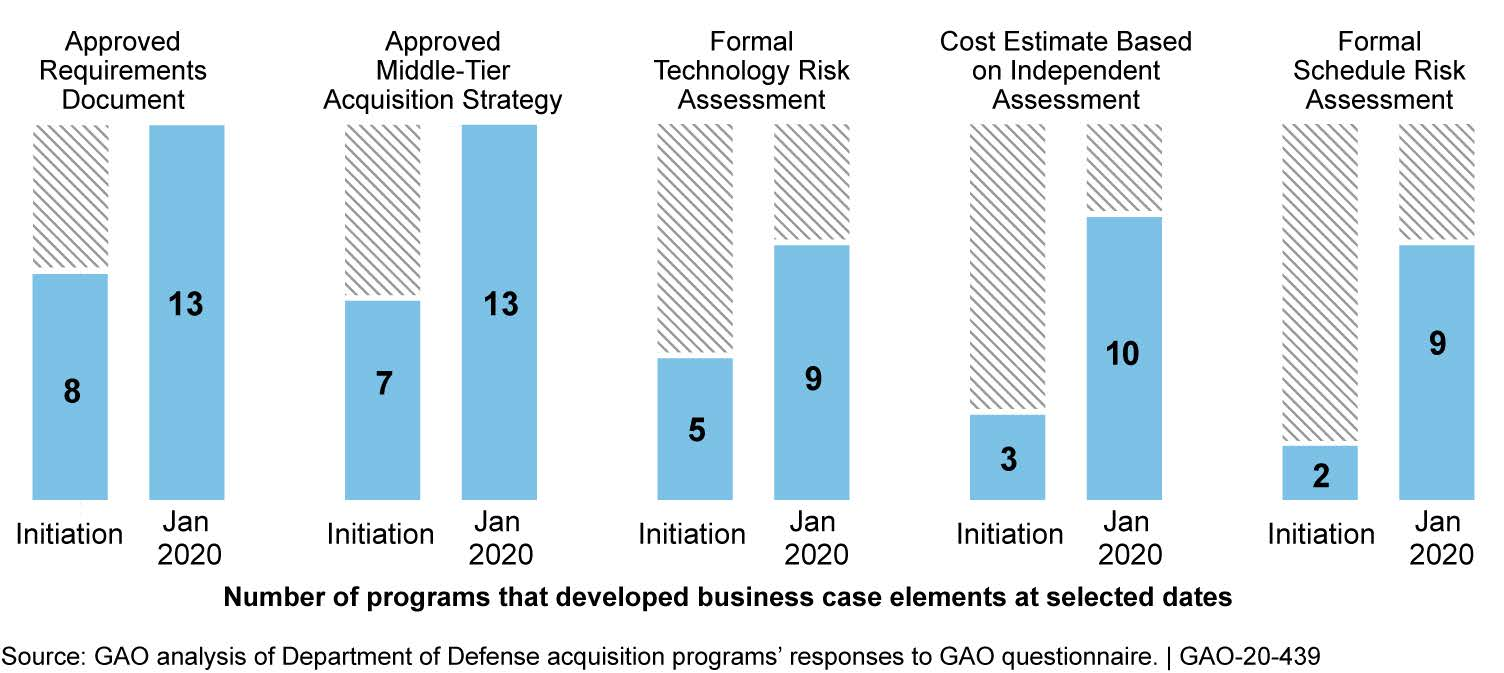Defense Acquisitions Annual Assessment: Drive to Deliver Capabilities Faster Increases Importance of Program Knowledge and Consistent Data for Oversight
Fast Facts
For our 18th annual assessment of DOD’s weapon programs, we looked at DOD’s plans to acquire about $1.8 trillion worth of new weapons systems.
DOD is focused on delivering these weapons quickly, and in some cases has started using a more streamlined process to do so. However, for many of the programs we looked at, DOD did not take steps to help achieve its goal, such as completing certain planning and testing steps before making decisions.
Also, DOD leaders may not have complete information about programs using the streamlined process, which could make it hard for them to know if the programs can deliver new systems as quickly as promised.
Artist’s Rendering of the Army’s Mobile Protected Firepower Vehicle

Tanks in a field
Highlights
This is GAO’s 18th annual assessment of DOD acquisition programs. GAO’s prior assessments covered major defense acquisition programs. This year’s assessment expands to include selected major IT systems and rapid prototyping and rapid fielding programs, in response to a provision in the National Defense Authorization Act for Fiscal Year 2019.
This report (1) summarizes the characteristics of 121 weapon and IT programs, (2) examines cost and schedule measures and other topics for these same programs, and (3) summarizes selected organizational and legislative changes. GAO identified the 121 programs for review based on their cost and acquisition status. GAO selected organizational and legislative changes that it determined related to the execution and oversight of the 121 programs.
GAO reviewed relevant legislation and DOD reports, collected data from program offices through a questionnaire, and interviewed DOD officials.
Additional analyses and assessments of major IT programs are included in a companion report to be issued later this year.
The Department of Defense (DOD) currently plans to invest over $1.8 trillion to acquire new major weapon systems such as aircraft, ships, and satellites. At the same time, the department is investing billions more in information technology (IT) systems and capabilities that it expects to either prototype or field rapidly through a new middle-tier acquisition pathway. (See table.)
Department of Defense Planned Investments in Selected Acquisition Programs GAO Reviewed (Fiscal Year 2020 Dollars in Billions)
| Type of program | Number of programs reviewed | Total investment |
| Major defense acquisition programs (current and future) | 93 | $1823.8 |
| Major information technology program | 15 | $15.1 |
| Middle-tier acquisition programs | 13 | $19.5 |
| Total | 121 | $1858.4 |
Source: GAO analysis of Department of Defense data. | GAO-20-439
Note: Cost estimates for some future major defense acquisition programs and middle-tier acquisition programs do not represent DOD’s full level of planned investment.
In recent years, Congress enacted reforms that could help streamline acquisition oversight and deliver capabilities faster. In January 2020, in part to improve the speed of the acquisition system, DOD reissued its foundational acquisition guidance. The new guidance includes six acquisition pathways based on the characteristics and risk profile of the system being acquired, including three that relate to the three types of programs GAO reviewed: 1) major capability acquisition, used to acquire major defense acquisition programs (MDAP); 2) middle-tier acquisition (MTA), used for rapid prototyping and rapid fielding efforts; and 3) defense business systems, used to acquire certain major IT programs. GAO’s observations on MDAPs and MTA programs are discussed below.
Major Defense Acquisition Programs
MDAPs are generally programs designated by the Secretary of Defense as such or that are estimated to require eventual total expenditure for research, development, test, and evaluation of more than $480 million, or for procurement of more than $2.79 billion, in fiscal year 2014 constant dollars.
MDAPs have generally stabilized non-quantity-related cost growth and schedule growth but continue to proceed with limited knowledge and inconsistent software development approaches and cybersecurity practices. Between 2018 and 2019, total acquisition cost estimates for DOD’s 85 current MDAPs grew by a combined $64 billion (a 4 percent increase), growth that was driven by decisions to increase planned quantities of some weapon systems. For example, DOD more than doubled in the past year the total number of missiles it plans to acquire through the Air Force’s Joint Air-to-Surface Standoff Missile program. Also between 2018 and 2019, capability delivery schedules for MDAPs increased, on average, by just over 1 month (a 1 percent increase). However, MDAPs’ cost and schedule performance is less encouraging as measured against their original approved program baselines. MDAPs have accumulated over $628 billion (or 54 percent) in total cost growth since program start, most of which is unrelated to the increase in quantities purchased. Additionally, over the same time period, time required to deliver initial capabilities has increased by 30 percent, resulting in an average delay of more than 2 years.
Many MDAPs continue to move forward without the benefit of knowledge at key acquisition points. GAO has found a correlation between implementation of certain practices and improved cost and schedule performance (see table).
Statistically Significant Knowledge-Based Acquisition Practices and Their Corresponding Unit Cost and Schedule Outcomes
| Knowledge practice |
Programs that implemented the practice |
Programs that did not implement the practice | Net performance difference |
|
Complete a system-level preliminary design review prior to system development |
|
|
|
|
Release at least 90 percent of design drawings by critical design review |
|
|
|
|
Test a system-level integrated prototype by critical design review |
|
|
|
Source: GAO analysis of Department of Defense data. │GAO-20-439
GAO also found inconsistent implementation of leading software practices and cybersecurity measures among MDAPs. This included longer-than-expected delivery times for software and delays completing cybersecurity assessments—outcomes disruptive to DOD’s efforts to keep pace with warfighters’ needs for enhanced, software-dependent capabilities and protect weapon systems from increasingly sophisticated cybersecurity threats.
Middle-Tier Acquisition Programs
Statute required DOD to establish guidance for rapid prototyping and rapid fielding pathways. These pathways are to provide a streamlined acquisition process for programs intended to field capabilities within 2 to 5 years. MTA programs are generally exempt from DOD’s traditional acquisition and requirements development processes.
DOD has taken steps to improve oversight of its costliest MTA programs, but challenges remain to tracking cost and schedule performance. The 13 programs GAO reviewed were expected to last about 4 years on average, although most planned follow-on efforts. For example, the Army’s Extended Range Cannon Artillery program plans two rapid prototyping spirals, followed by fielding. DOD issued guidance in December 2019 that increased oversight for MTA programs, including requiring certain business case documentation to help assess whether programs are well-positioned to field capabilities within 5 years. These document requirements were consistent with a June 2019 GAO recommendation. GAO found that while most MTA programs it reviewed were lacking some or all of these documents at program initiation, they had made significant progress in receiving approval of these documents by the time of this review (see figure).
MTA Program Completion of Key Program Business Case Documentation

GAO observed inconsistent cost reporting and wide variation in schedule metrics across MTA programs, which pose oversight challenges for Office of the Secretary of Defense and military department leaders trying to assess performance of these programs. According to DOD officials, the department is in the process of improving MTA program data.
For more information, contact Shelby S. Oakley at (202) 512-4841 or oakleys@gao.gov.
